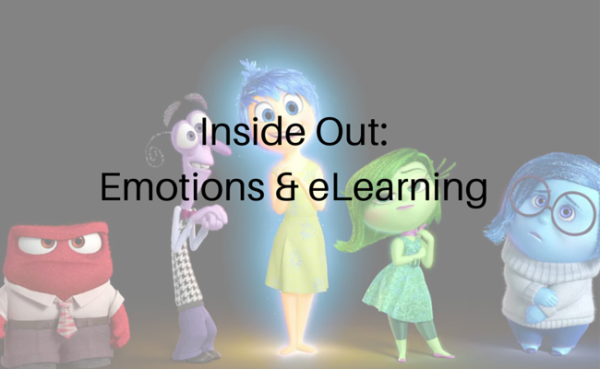
Pixar recently released its newest animated film, Inside Out, which focuses on the emotions of an 11-year-old girl. These emotions take form as colorful characters with famous celebrity voices: Joy (Amy Poehler), Sadness (Phyllis Smith), Disgust (Mindy Kaling), Anger (Lewis Black), and Fear (Bill Hader.)
Throughout the film, these core emotions fight over who gets to influence the girl’s actions and reactions, demonstrating the internal struggle that is part of the human experience.
The film made us think about how emotions and eLearning, too. While the average eLearner isn’t an 11-year-old girl, every individual wrestles with these emotions throughout the learning experience. So shouldn’t we take those into consideration when developing a course? We think so.
Let’s look at each of these emotions and see how it ties in with eLearning.
Joy
Amy Poehler’s character is happy, bubbly, and fun loving. To activate an eLearner’s personal “Joy”, an Instructional Designer needs to incorporate elements of fun—like games that test a user’s knowledge, interesting drag and drop features, and interactive elements that turn the course into a challenge for the learner.
For example: Say you’re developing an eLearning course that reviews an HR policy, and the material is a little…dry. Incorporating a game element, such as, “Hurry…you have two minutes to run around the office and find the violations before the inspector gets here!” can make the material more stimulating and enjoyable for the trainee.
Sadness
At first thought, you might not think that Sadness (the mopey, depressed, unmotivated character in the film) has a place within an eLearning course. But, in fact, it does. Sadness can be a powerful sentiment when used in scenarios that require learners to respond emotionally to a situation.
For example: Say you are building an eLearning course for customer service training. A trainee has to interact with a customer who has just lost a loved one. In this situation, you’d want your customer service representative to respond with an element of empathy (a cousin of sadness.) This can be achieved by demonstrating appropriate responses and interactions in this scenario. It is this connection with the scenario, and thus the material, that will resonate with the learner and create a learning moment.
Disgust
Mindy Kaling does a great voice for the emotion that is perpetually fed up with everyone and everything she deems “gross.” And in an eLearning course, channeling your inner Mindy Kaling can help get the point across with negative behaviors. Disgust makes us see and differentiate acceptable and unacceptable norms.
For example: Say you’re designing a course for food service workers and you need to demonstrate why sanitation is so vital to their day-to-day work. Evoking disgust in the form of statistics and visuals of bacteria and mold that come as a result of neglecting sanitation would be a powerful way to drive the message home.
Anger
Hotheaded anger is often an emotion we want eLearners to avoid at all costs. Inside Out shows the negative effects of uncontrolled anger—and so can you, in your eLearning course. Again, this is particularly useful in sales and customer service training. Use anger to show learners what NOT to do.
For example: If you’re creating a course for a sales team, include video and audio examples of different types of angry responses from customers, and then teach the learners how to appropriately respond. This type of emotional intelligence can go a long way for your brand.
Fear
Fear can be a powerful motivator to avoid negative behaviors—and to achieve positive ones. Stirring up a little bit of anxiety in an eLearning course helps the learner stay alert and active during the training.
For example: Putting a timer on a quiz portion of the course gets the learner moving quickly and thinking on his or her feet. There are only a short bursts of fear evoked here, but without it, it may not produce the same positive results. The fear of failure is often missing in many of our learning experiences. Risk of failure can add significant value by making the learner feel he or she has something on the line (even if that is something as simple as their desired outcome.)
Emotions and eLearning
Thinking back to some of your most memorable learning experiences, they almost certainly evoked some type of emotion. As people, this is how we make the strongest connections.
Why not leverage this powerful tool in eLearning as well? Not only will your learners be creating stronger connections to your material, but they’ll be better equipped to respond to the emotions of others as well. By doing this, they will be leveraging their own emotions to get the best possible learning experience you can give them. The subtle emotions you work into your course will produce a well-rounded learner who can get the most out of their training.
